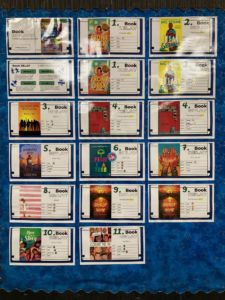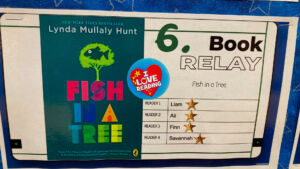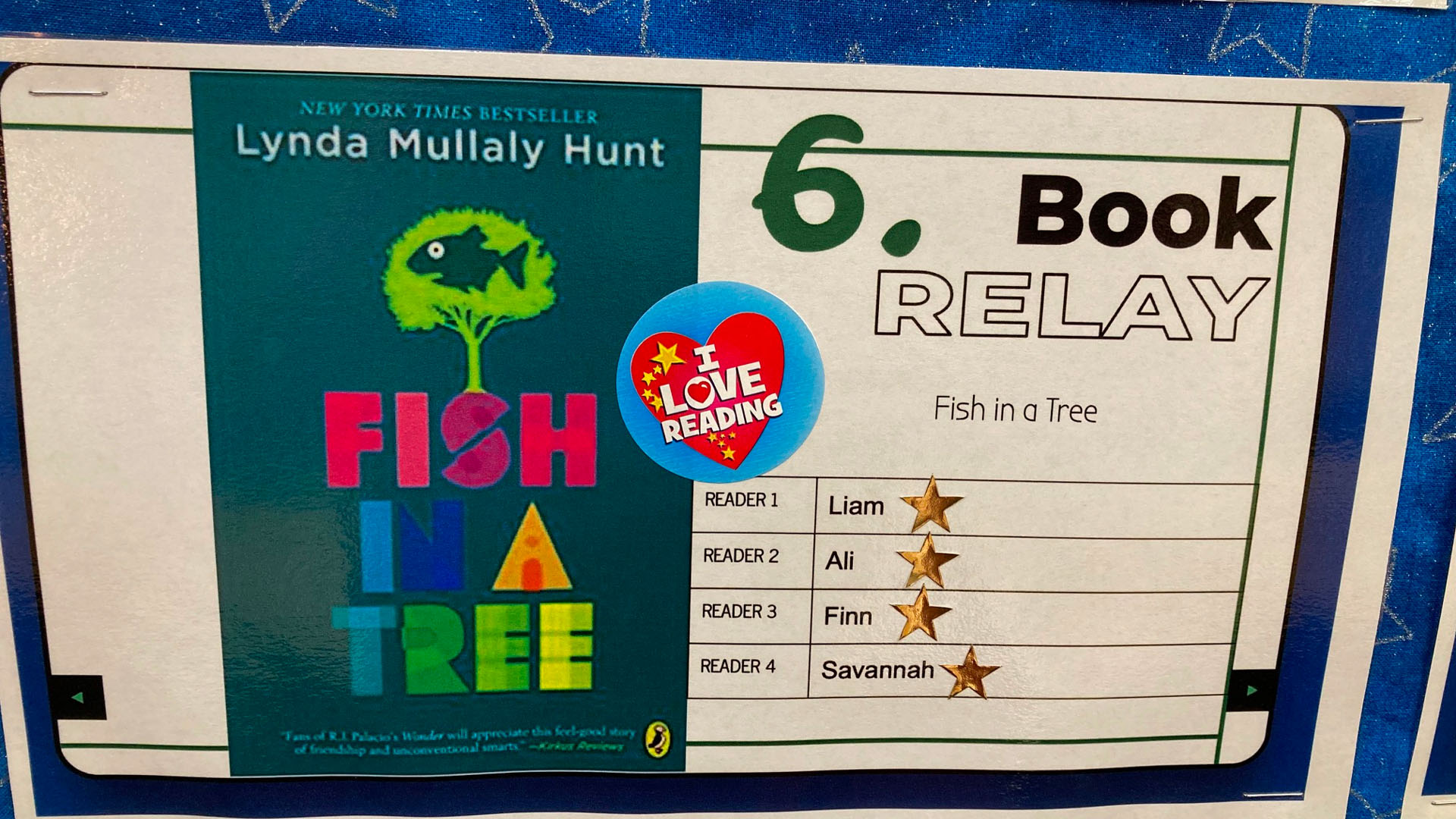One of the most challenging tasks at the start of a school year is helping students find books and build their reading stamina. Students struggle with finding great books to read and forming a solid reading community. You may have experienced students trying to wander during reading time to “find” a book. Maybe you can relate to students who “pretend” to be reading. Another tactic students take is the abandonment of books strategy. We witness students jumping from book to book rather than reaching the finish line of text. Our goal as educators is to develop a reading environment where students are so engaged in books that the strategies of avoidance disappear from the classroom. What might help our readers appreciate books more? How do we build passion for reading? Let’s increase their time in text!
Our goal as educators is to develop a reading environment where students are so engaged in books that the strategies of avoidance disappear from the classroom.
While reading the book, Leading Literate Lives by Stephanie Affinito, I came across the idea of book relays. As Affinito stated, “The book relay is an innovative way to bring teachers together around books they can share with their students.” Immediately, I started thinking about how students might like the process of choosing from a list of books, forming teams of four, reading the book, and passing it on to the next reader. What would the choices do for readers’ literacy lives? How would classmates encourage each other to finish books? What does a little competition do for readers? Out of this thinking came the desire to set up book relays for my fifth grade readers.
Developing Book Relays
At the start of the year, I organized fifteen titles of realistic fiction books that shared all different perspectives and lenses through characters. For a few class periods, I shared book talks on the titles so the students would be familiar with the titles of the books. The book talks also helped to gain interest in the different books. I left the books out on display in the classroom as I talked about each one. When we were finished with the book talks, the students filled out a Google form with their top two choices. The information went to a spreadsheet that allowed me to form relay teams.  All of the books were books that I had read, except for one new title that I was familiar with from our teacher librarian. By having one book that I had not read, I was able to place myself on a relay team with the kids. After the groups were formed, I made a bulletin board display so students could see the book covers and teams. Some of the books were not chosen and some titles had more interest. There were a few books with multiple teams. The display had the names of the readers on the team so that each reader could be encouraged. The books were checked out through our school library and passed out for students to begin. As students finished books, we placed stars next to their name. The visual allowed the groups to know who they were encouraging. The process of setting up book relays surpassed my hopes for my readers. First of all, the first library session after the relays began students were checking out books from different relays because they wanted to read them. Some students gravitated to the books that were not chosen as a full relay team. Students were not wandering looking for books. Our daily reading time was building stamina quickly as students wanted to make progress in their books. The room was buzzing with conversation about the books and how great they were. It was easy to promote the idea of finishing a book in two weeks’ time. Students came to a small group, so they could work with me to plan how to set up daily reading targets to reach their two week goal. We used Post-It notes to mark starting and stopping points. Students were reading more at home so that they could finish their goals for the day. Many of the groups had a first reader done in less than a week.The first relay team finished before midterm. Readers have continued to read books from the relay list even after they have finished their role on a team. It takes about two quarters for all teams to cross the finish line.
All of the books were books that I had read, except for one new title that I was familiar with from our teacher librarian. By having one book that I had not read, I was able to place myself on a relay team with the kids. After the groups were formed, I made a bulletin board display so students could see the book covers and teams. Some of the books were not chosen and some titles had more interest. There were a few books with multiple teams. The display had the names of the readers on the team so that each reader could be encouraged. The books were checked out through our school library and passed out for students to begin. As students finished books, we placed stars next to their name. The visual allowed the groups to know who they were encouraging. The process of setting up book relays surpassed my hopes for my readers. First of all, the first library session after the relays began students were checking out books from different relays because they wanted to read them. Some students gravitated to the books that were not chosen as a full relay team. Students were not wandering looking for books. Our daily reading time was building stamina quickly as students wanted to make progress in their books. The room was buzzing with conversation about the books and how great they were. It was easy to promote the idea of finishing a book in two weeks’ time. Students came to a small group, so they could work with me to plan how to set up daily reading targets to reach their two week goal. We used Post-It notes to mark starting and stopping points. Students were reading more at home so that they could finish their goals for the day. Many of the groups had a first reader done in less than a week.The first relay team finished before midterm. Readers have continued to read books from the relay list even after they have finished their role on a team. It takes about two quarters for all teams to cross the finish line.
 Thoughts from Students
Thoughts from Students
“I thought it was a fun challenge. It made it a fun way to finish a book. Normally, it takes me a while.” (Savanah, 5th grade) “It was cool to have a challenge.” (Josie, 5th grade) “It encouraged me to read more because I am competitive. I knew if a book won, I could read it. The title seemed weird [Fish in a Tree] and I was interested.” (Maddux, 5th grade) “Can we do more relays this year? Can we do fantasy?” (Larkin, 5th grade)
Tips from the Relays
My classes are made up of a wide variety of readers. I have students with IEP’s, and I have high ability readers. Be flexible with your readers. For example, maybe you need to have partners take a leg of a relay so they may read together. Allow students to access text in print and audio books. We used the Libby app and the Hoopla app to gain access to audio through the public library. Audio helps students have a fluent model to follow along with while holding the book. It also allowed all readers the ability to participate. These apps worked well with our one-to-one iPads and a pair of earbuds. Allow students to leave questions or connections in the books on Post-It notes. It was certainly more fun for the other readers. Students can leave notes for the next reader to come find them when they reach a spot in the book. Some students wanted to connect with other readers and this gave them a system. Plus, we were learning how to think while reading and using “thinking spots” in our mini-lessons. If you read one of the books too, it gives you an authentic way to model for your readers. Having students using a lot of great books at the start allowed me to have effective one-on-one conferences with my students. It was easy to see if a student was understanding the story and inferring about the characters since I knew the books well. Students also had space to choose their own reading material since they were staggered in the relays. I was still able to get a sense of what types of books each student enjoyed Let your families know what you are doing. Some of my parents were excited to partner with their child and help them reach their goals at home. Parents appreciated knowing other books they could guide their readers to right away too. Home reading improves skills and getting parents excited helps. One problem I faced was allowing readers to sign up for multiple books. I never want to limit a reader. However, it just did not work out too well. One student begged to be on multiple relays. We tried to have her be a first reader, a third reader, and a fourth reader. She still ended up with multiple books at a time. Then classmates were frustrating her because they wanted their book to be the next one she finished. The dynamic was not the same. My advice would be for each reader to be on one team. Encourage readers to choose more for their self-selected reads. Trust me, they will. If you are interested in trying a book relay, use the resources provided or adapt them for your own use. Happy reading relays!
Resources
Please login or register to claim PGPs.
Alternatively, you may use the PGP Request Form if you prefer to not register an account.



